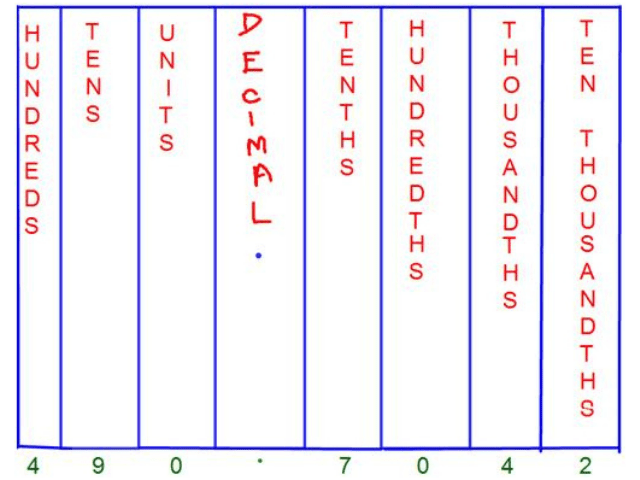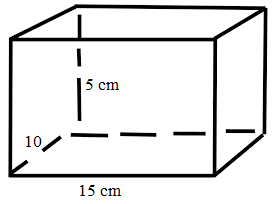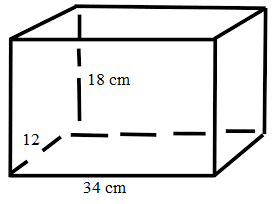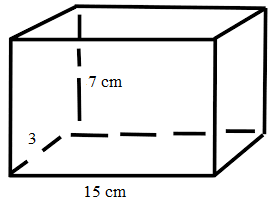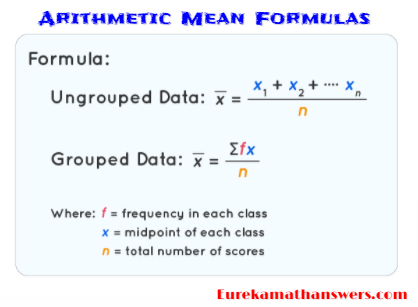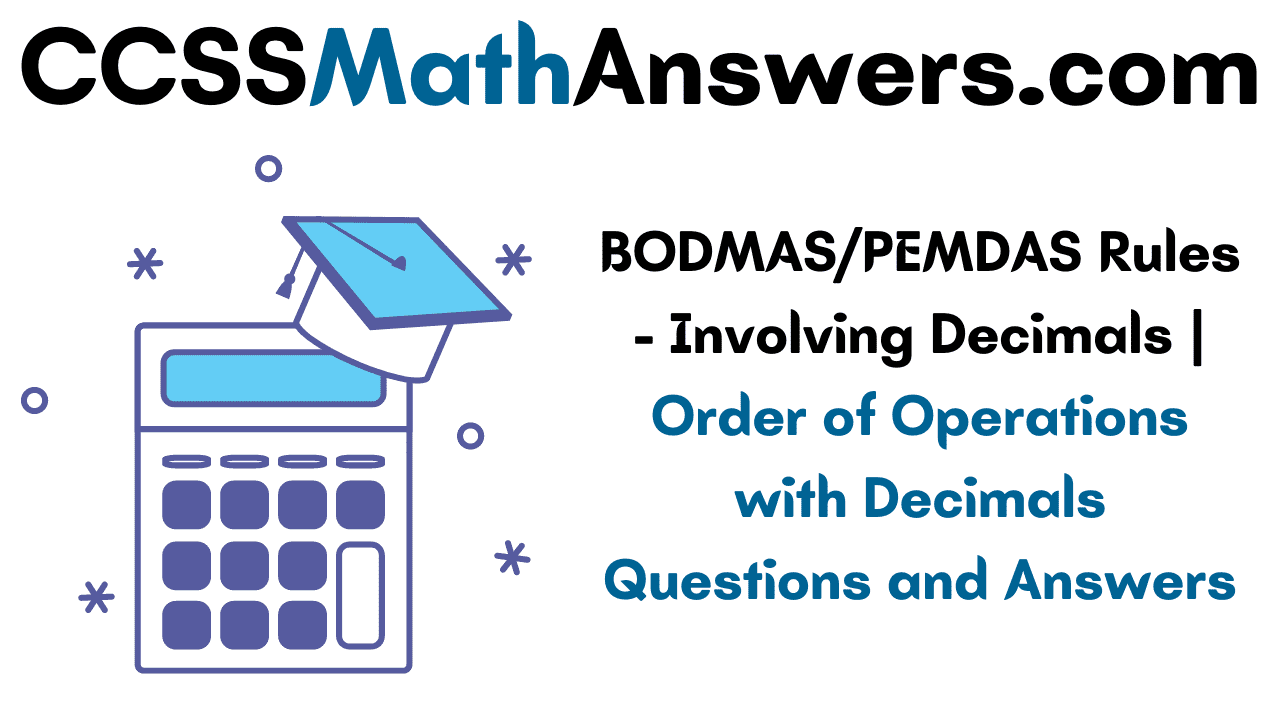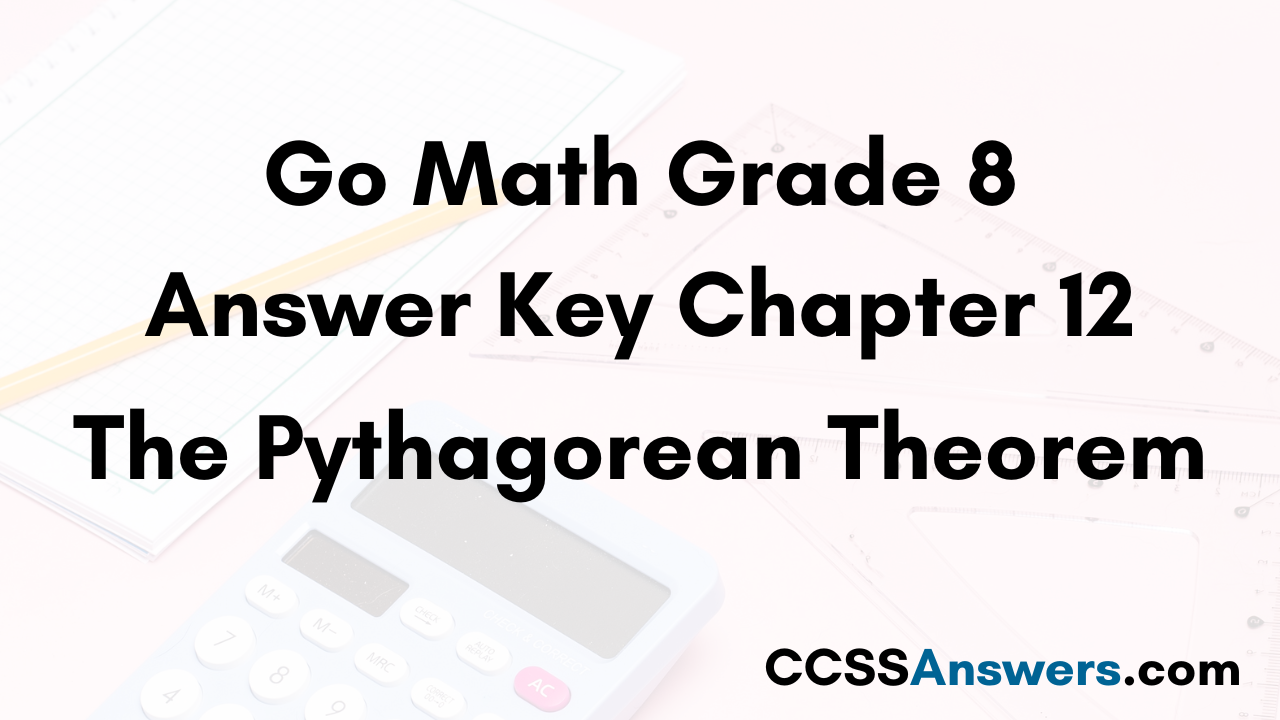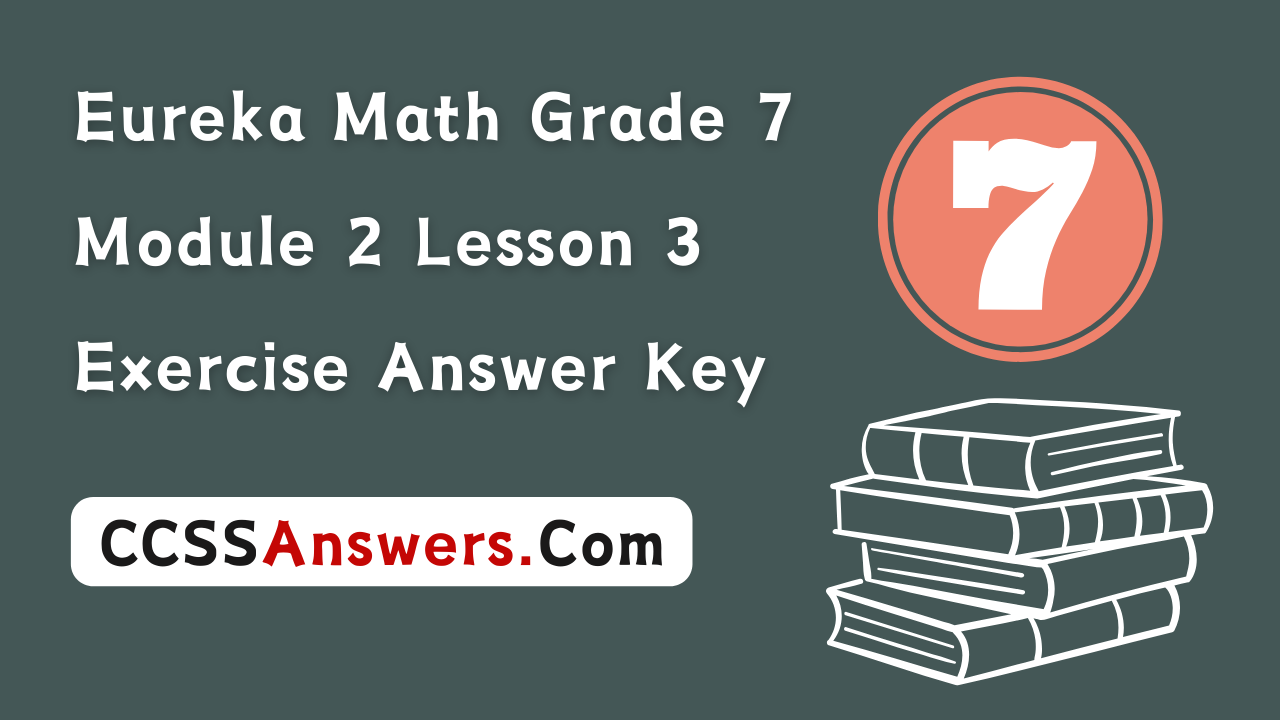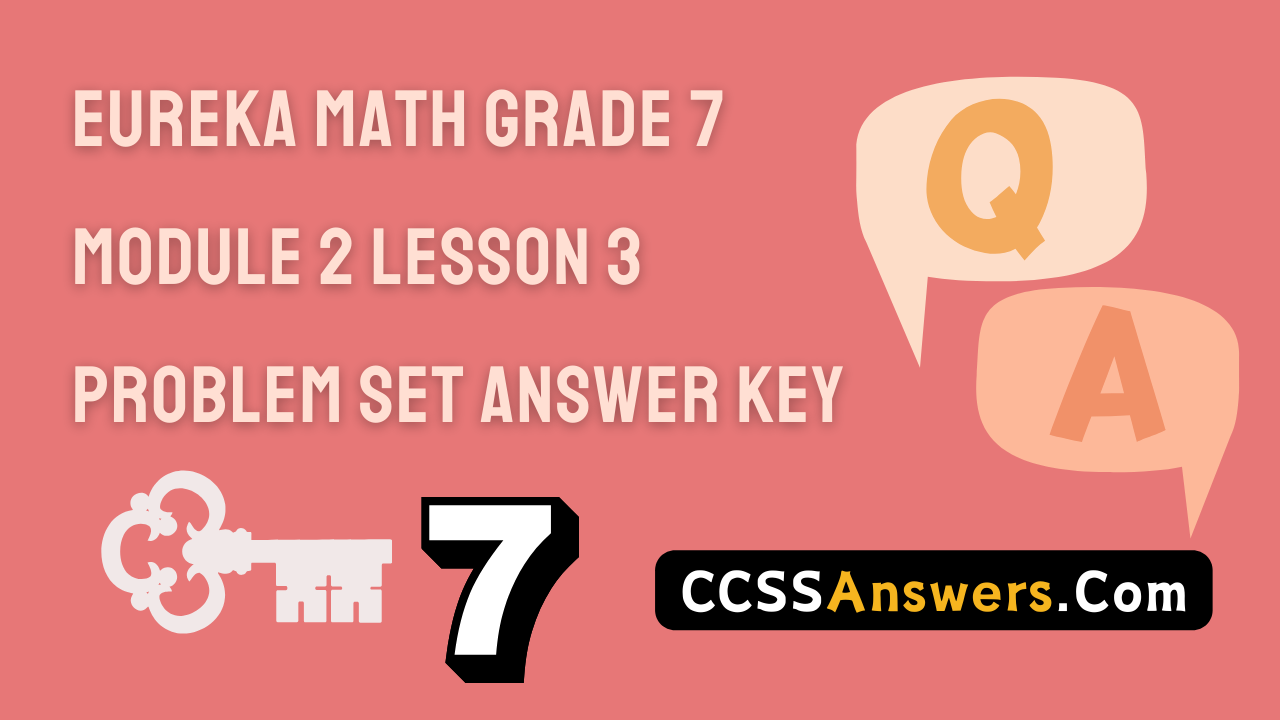One has to learn the concepts if he/she wants to become a master in maths. The fundamentals in Go Math Grade 8 Answer Key Chapter 12 The Pythagorean theorem will help you to learn the subject. You need to practice from the beginning itself. We will help you to achieve your dreams by providing simple methods to solve the problems in an easy manner. Download Go Math Grade 8 Answer Key Chapter 12 The Pythagorean Theorem free pdf to help you to gain a grip over the subject.
Go Math Grade 8 Answer Key Chapter 12 The Pythagorean Theorem
Go Math Grade 8 Answer Key Chapter 12 The Pythagorean Theorem will help you to complete your homework in time without any mistakes. The main aim of the ccssanswers.com site is to provide quick and simple methods to all the students of 8th grade. The solutions to all the questions in Go Math Grade 8 Answer Key Chapter 12 The Pythagorean Theorem are prepared by the math experts. Tap the links and practice the problems provided in the HMH Go Math 8th Grade Solution Key Chapter 12 The Pythagorean Theorem.
Chapter 12- Lesson 1:
Chapter 12- Lesson 2:
Chapter 12- Lesson 3:
Guided Practice – The Pythagorean Theorem – Page No. 378

Question 1.
Find the length of the missing side of the triangle

a2 + b2 = c2 → 242 + ? = c2 → ? = c2
The length of the hypotenuse is _____ feet.
_____ feet
Answer: The length of the hypotenuse is 26 feet.
Explanation: According to Pythagorean Theorem, we shall consider values of a = 24ft, b = 10ft.
Therefore c = √(a2 +b2)
c = √(242 + 102)
= √(576 + 100)
= √676 = 26ft
Question 2.
Mr. Woo wants to ship a fishing rod that is 42 inches long to his son. He has a box with the dimensions shown.

a. Find the square of the length of the diagonal across the bottom of the box.
________ inches
Answer: 1700 inches.
Explanation: Here we consider the length of the diagonal across the bottom of the box as d.
Therefore, according to Pythagorean Theorem
W2 + l2 = d2
402 + 102 = d2
1600 + 100 = d2
1700 = d2
Question 2.
b. Find the length from a bottom corner to the opposite top corner to the nearest tenth. Will the fishing rod fit?
________ inches
Answer: 42.42 inches.
Explanation: We denote by r, the length from the bottom corner to the opposite top corner. We use our Pythagorean formula to find r.
h2 + s2 = r2
102 + 1700 = r2
100 + 1700 = r2
1800 = r2, r = √1800 => 42.42 inches
ESSENTIAL QUESTION CHECK-IN

12.1 Independent Practice – The Pythagorean Theorem – Page No. 379

Find the length of the missing side of each triangle. Round your answers to the nearest tenth.
Question 4.
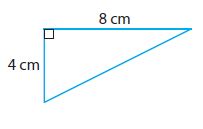
________ cm
Answer: 8.9 cm.
Explanation: According to Pythagorean theorem we consider values of a = 4cm, b = 8cm.
c2 = a2 + b2
= 42 + 82
= 16 + 64
c2= 80, c= √80 => 8.944
After rounding to nearest tenth value c= 8.9cm
Question 5.

________ in.
Answer: 11.5 in.
Explanation: According to Pythagorean theorem we consider values of b = 8in, c= 14in
c2 = a2 + b2
142 = a2 + 82
196 = a2 + 64
a2 = 196 – 64
a = √132 => 11.4891
a = 11.5 in
Question 6.
The diagonal of a rectangular big-screen TV screen measures 152 cm. The length measures 132 cm. What is the height of the screen?
________ cm
Answer: 75.4 cm
Explanation: Let’s consider the diagonal of the TV screen as C = 152cm, length as A = 132 cm, and height of the screen as B.
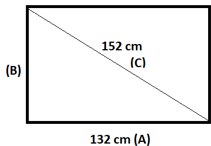
As C2 = A2 + B2
1522 = 1322 + B2
23,104 = 17,424 + B2
B2 = 23,104 – 17,424
B = √5680 => 75.365
So the height of the screen B = 75.4cm
Question 7.
Dylan has a square piece of metal that measures 10 inches on each side. He cuts the metal along the diagonal, forming two right triangles. What is the length of the hypotenuse of each right triangle to the nearest tenth of an inch?
________ in.
Answer: 14.1in.
Explanation:
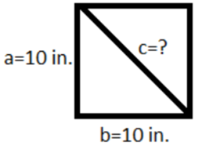
Using the Pythagorean Theorem, we have:
a2 + b2 = c2
102 + 102 = c2
100 + 100 = c2
200 = c2
We are told to round the length of the hypotenuse of each right triangle to the nearest tenth of an inch, therefore: c = 14.1in
Question 8.
Represent Real-World Problems A painter has a 24-foot ladder that he is using to paint a house. For safety reasons, the ladder must be placed at least 8 feet from the base of the side of the house. To the nearest tenth of a foot, how high can the ladder safely reach?
________ ft
Answer: 22.6 ft.
Explanation: Consider the below diagram. Length of the ladder C = 24ft, placed at a distance from the base B = 8ft, let the safest height be A.
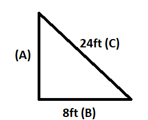
By using Pythagorean Theorem:
C2 = A2 + B2
242 = A2 + 82
576 = A2 + 64
A2 = 576 – 64 => 512
A = √512 => 22.627
After rounding to nearest tenth, value of A = 22.6ft
Question 9.
What is the longest flagpole (in whole feet) that could be shipped in a box that measures 2 ft by 2 ft by 12 ft?
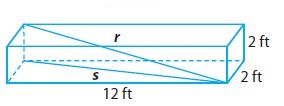
________ ft
Answer: The longest flagpole (in whole feet) that could be shipped in this box is 12 feet.
Explanation: From the above diagram we have to find the value of r, which gives us the length longest flagpole that could be shipped in the box. Where width w = 2ft, height h = 2ft and length l = 12ft.
First find s, the length of the diagonal across the bottom of the box.
w2 + l2 = s2
22 + 122 = s2
4 + 144 = s2
148 = s2
We use our expression for s to find r, since triangle with sides s, r, and h also form a right-angle triangle.
h2 + s2 = r2
22 + 148 = r2
4 + 148 = r2
152 = r2
r = 12.33ft.
Question 10.
Sports American football fields measure 100 yards long between the end zones, and are 53 \(\frac{1}{3}\) yards wide. Is the length of the diagonal across this field more or less than 120 yards? Explain.
____________
Answer: The diagonal across this field is less than 120 yards.
Explanation: From the above details we will get a diagram as shown below.

We are given l = 100 and w = 53 = . If we denote with d the diagonal of the field, using the Pythagorean Theorem, we have:
l2 + w2 = d2
1002 + (160/3)2 = d2
10000 + (25600/9) = d2
9*10000 + 9*(25600/9) = 9* d2
90000 + 25600 = 9 d2
(115600/9) = d2
(340/9) = d2
d = 113.3
Hence the diagonal across this field is less than 120 yards.
Question 11.
Justify Reasoning A tree struck by lightning broke at a point 12 ft above the ground as shown. What was the height of the tree to the nearest tenth of a foot? Explain your reasoning.

________ ft
Answer: The total height of the tree was 52.8ft
Explanation:
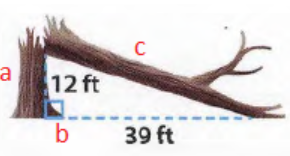
By using the Pythagorean Theorem
a2 + b2 = c2
122 + 392 = c2
144 + 1521 = c2
1665 = c2
We are told to round the length of the hypotenuse to the nearest tenth of a foot, therefore: c = 40.8ft.
Therefore, the total height of the tree was:
height = a+c
height = 12 +40.8
height = 52.8 feet
FOCUS ON HIGHER ORDER THINKING – The Pythagorean Theorem – Page No. 380
Question 12.
Multistep Main Street and Washington Avenue meet at a right angle. A large park begins at this corner. Joe’s school lies at the opposite corner of the park. Usually, Joe walks 1.2 miles along Main Street and then 0.9 miles up Washington Avenue to get to school. Today he walked in a straight path across the park and returned home along the same path. What is the difference in distance between the two round trips? Explain.
________ mi
Answer: Joe walks 1.2 miles less if he follows the straight path across the park.
Explanation: Using the Pythagorean Theorem, we find the distance from his home to school following the straight path across the park:
a2 + b2 = c2
1.22 + 0.92 = c2
1.44 + 0.81 = c2
2.25 = c2
1.5 = c
Therefore, the distance of Joe’s round trip following the path across the park is 3 miles (dhome-school + dschool-home = 1.5 + 1.5). Usually, when he walks along Main Street and Washington Avenue, the distance of his round trip is 4.2 miles (dhome-school + dschool-home = (1.2 + 0.9) + (0.9+1.2)). As we can see, Joe walks 1.2 miles less if he follows the straight path across the park.
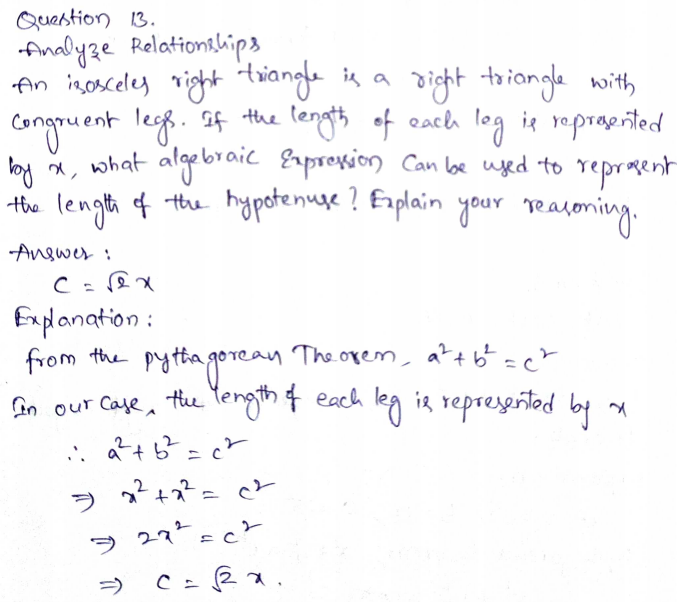
Question 14.
Persevere in Problem-Solving A square hamburger is centered on a circular bun. Both the bun and the burger have an area of 16 square inches.
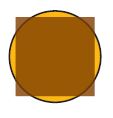
a. How far, to the nearest hundredth of an inch, does each corner of the burger stick out from the bun? Explain.
________ in
Answer: Each corner of the burger sticks out 0.57 inches from the bun.
Explanation: Frist, we need to find the radius r of the circular bun. We know that its area A is 16 square inches, therefore:
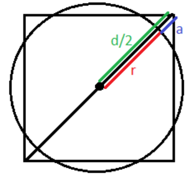
A = πr2
16 = 3.14*r2
r2 = (16/3.14)
r = 2.26
Then, we need to find the sides of the square hamburger. We know that its area A is 16 square inches, therefore:
A = s2
16 = s2
s = 4
Using the Pythagorean Theorem, we have to find the diagonal d of the square hamburger:
s2 + s2 = d2
42 + 42 = d2
16 + 16 = d2
32 = d2
d = 5.66
To find how far each corner of the burger sticks out from the bun, we denote this length by a and we get:
a = (d/2) – r => (5.66/2) – 2.26
a = 0.57.
Therefore, Each corner of the burger sticks out 0.57 inches from the bun.
Question 14.
b. How far does each bun stick out from the center of each side of the burger?
________ in
Answer: Each bun sticks out 0.26 inches from the center of each side of the burger.
Explanation:

We found that r = 2.26 and s = 4. To find how far does each bun stick out from the center of each side of the burger, we denote this length by b and we get:
b = r – (s/2) = 2.26 – (4/2)
b = 0.26 inches.
Question 14.
c. Are the distances in part a and part b equal? If not, which sticks out more, the burger or the bun? Explain.
Answer: The distances a and b are not equal. From the calculations, we found that the burger sticks out more than the bun.
Guided Practice – Converse of the Pythagorean Theorem – Page No. 384
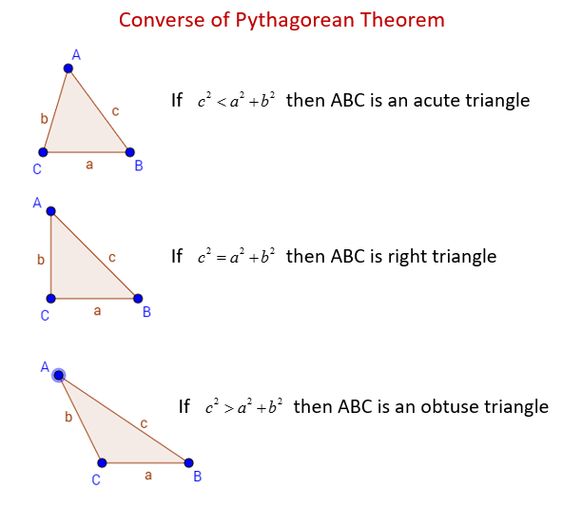
Question 1.
Lashandra used grid paper to construct the triangle shown.

a. What are the lengths of the sides of Lashandra’s triangle?
_______ units, _______ units, _______ units,
Answer: The length of Lashandra’s triangle is 8 units, 6 units, 10 units.
Question 1.
b. Use the converse of the Pythagorean Theorem to determine whether the triangle is a right triangle.

The triangle that Lashandra constructed is/is not a right triangle.
_______ a right triangle
Answer: Lashandra’s triangle is right angled triangle as it satisfied the Pythagorean theorem
Explanation:
Verifying with Pythagorean formula a2 + b2 = c2
82 + 62 = 102
64 + 36 =100
100 = 100.
Question 2.
A triangle has side lengths 9 cm, 12 cm, and 16 cm. Tell whether the triangle is a right triangle.
Let a = _____, b = _____, and c = ______.
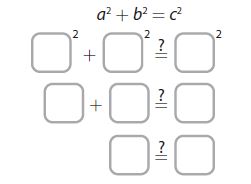
By the converse of the Pythagorean Theorem, the triangle is/is not a right triangle.
_______ a right triangle
Answer: The given triangle is not a right-angled triangle
Explanation: Verifying with Pythagorean formula a2 + b2 = c2
92 + 122 = 162
81 + 144 = 256
225 ≠ 256.
Hence given dimensions are not from the right-angled triangle.
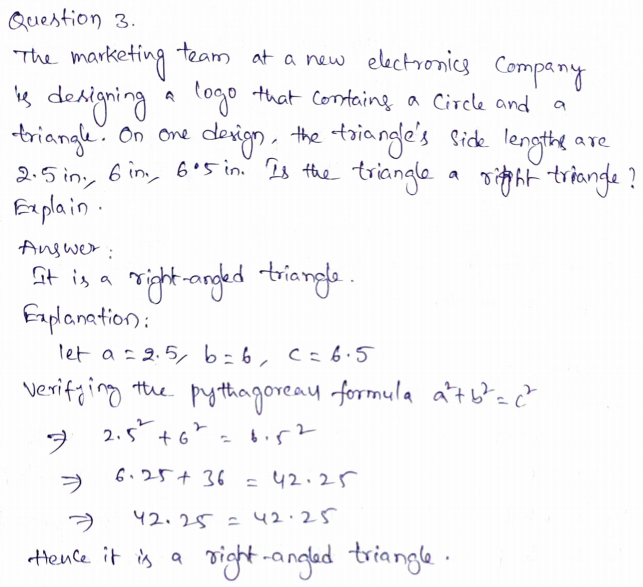
ESSENTIAL QUESTION CHECK-IN
Question 4.
How can you use the converse of the Pythagorean Theorem to tell if a triangle is a right triangle?
Answer:
Knowing the side lengths, we substitute them in the formula a2 + b2 = c2, where c contains the biggest value.
If the equation holds true, then the given triangle is a right triangle. Otherwise, it is not a right triangle.
12.2 Independent Practice – Converse of the Pythagorean Theorem – Page No. 385
Tell whether each triangle with the given side lengths is a right triangle.
Question 5.
11 cm, 60 cm, 61 cm
______________
Answer: Since 112 + 602 = 612, the triangle is a right-angled triangle.
Explanation: Let a = 11, b = 60 and c= 61
Using the converse of the Pythagorean Theorem a2 + b2 = c2
112 + 602 = 612
121 + 3600 = 3721
3721 = 3721.
Since 112 + 602 = 612, the triangle is a right-angled triangle.
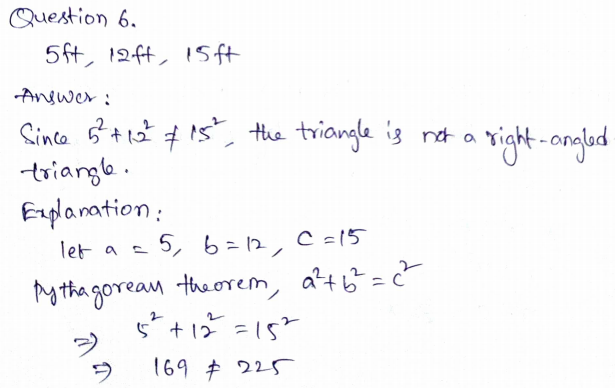
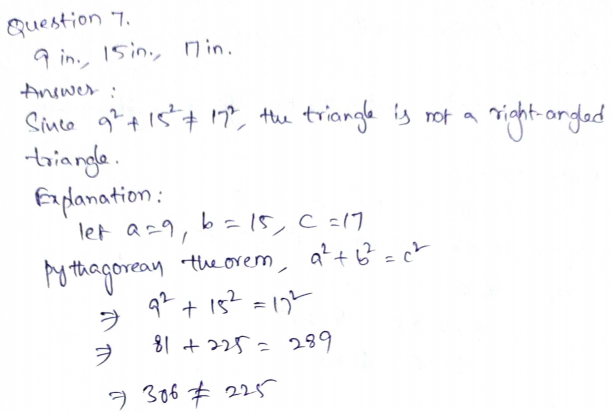
Question 8.
15 m, 36 m, 39 m
______________
Answer: Since 152 + 362 = 392, the triangle is a right-angled triangle.
Explanation: Let a = 15, b = 36 and c= 39
Using the converse of the Pythagorean Theorem a2 + b2 = c2
152 + 362 = 392
225 + 1296 = 1521
1521 = 1521.
Since 152 + 362 = 392, the triangle is a right-angled triangle.
Question 9.
20 mm, 30 mm, 40 mm
______________
Answer: Since 202 + 302 ≠ 402, the triangle is not a right-angled triangle.
Explanation: Let a = 20, b = 30 and c= 40
Using the converse of the Pythagorean Theorem a2 + b2 = c2
202 + 302 = 402
400 + 900 = 1600
1300 ≠ 1600.
Since 202 + 302 ≠ 402, the triangle is not a right-angled triangle.
Question 10.
20 cm, 48 cm, 52 cm
______________
Answer: Since 202 + 482 = 522, the triangle is a right-angled triangle.
Explanation: Let a = 20, b = 48 and c= 52
Using the converse of the Pythagorean Theorem a2 + b2 = c2
202 + 482 = 522
400 + 2304 = 2704
2704 = 2704.
Since 202 + 482 = 522, the triangle is a right-angled triangle.


Question 13.
35 in., 45 in., 55 in.
______________
Answer: Since 352 + 452 ≠ 552, the triangle is not a right-angled triangle.
Explanation: Let a = 35, b = 45 and c= 55
Using the converse of the Pythagorean Theorem a2 + b2 = c2
352 + 452 = 552
1225 + 2025 = 3025
3250 ≠ 3025.
Since 352 + 452 ≠ 552, the triangle is not a right-angled triangle.
Question 14.
25 cm, 14 cm, 23 cm
______________
Answer: Since 142 + 232 ≠ 252, the triangle is not a right-angled triangle.
Explanation: Let a = 14, b = 23 and c= 25 (longest side)
Using the converse of the Pythagorean Theorem a2 + b2 = c2
142 + 232 = 252
196 + 529 = 625
725 ≠ 625.
Since 142 + 232 ≠252, the triangle is not a right-angled triangle.
Question 15.
The emblem on a college banner consists of the face of a tiger inside a triangle. The lengths of the sides of the triangle are 13 cm, 14 cm, and 15 cm. Is the triangle a right triangle? Explain.
________
Answer: Since 132 + 142 ≠ 152, the triangle is not a right-angled triangle.
Explanation: Let a = 13, b = 14 and c= 15
Using the converse of the Pythagorean Theorem a2 + b2 = c2
132 + 142 = 152
169 + 196 = 225
365 ≠ 225.
Since 132 + 142 ≠ 152, the triangle is not a right-angled triangle.
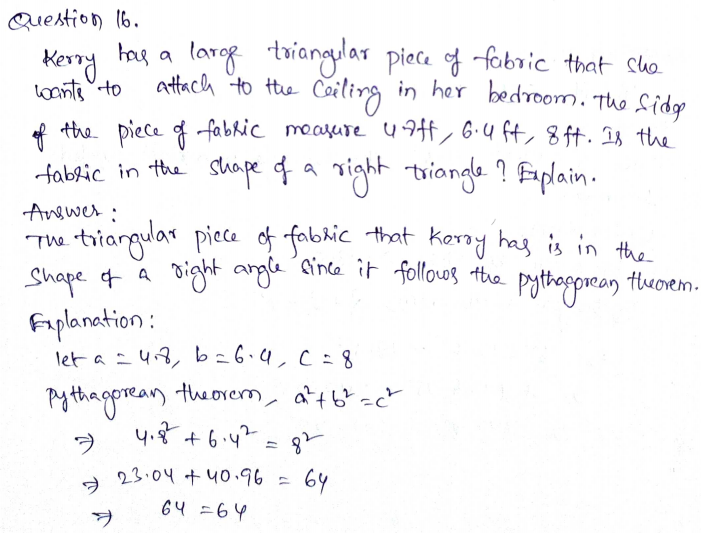
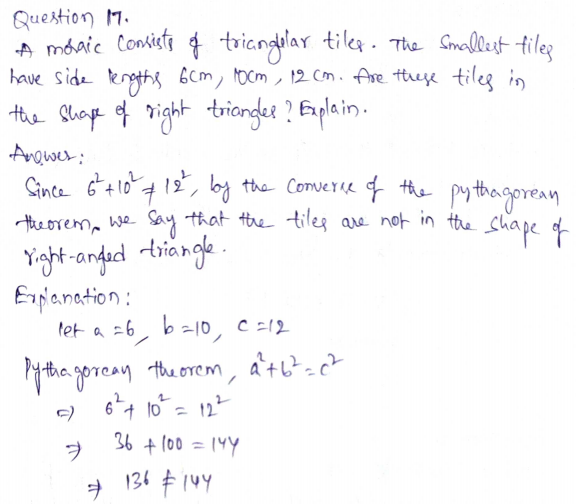
Question 18.
History In ancient Egypt, surveyors made right angles by stretching a rope with evenly spaced knots as shown. Explain why the rope forms a right angle.
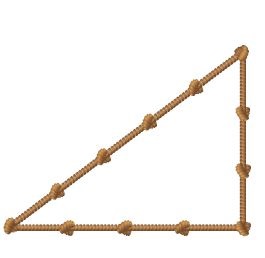
Answer: The rope has formed a right-angled triangle because the length of its sides follows Pythagorean Theorem.
Explanation: The knots are evenly placed at equal distances
The lengths in terms of knots are a=4 knots, b = 3knots, c = 5 knots
Therefore a2 + b2 = c2
42 + 32 = 52
16+9 = 25
25 = 25.
Hence rope has formed a right-angled triangle because the length of its sides follows Pythagorean Theorem.
Converse of the Pythagorean Theorem – Page No. 386
Question 19.
Justify Reasoning Yoshi has two identical triangular boards as shown. Can he use these two boards to form a rectangle? Explain.
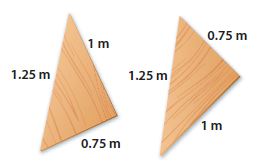
Answer: Since it was proved that both can form a right-angled triangle, we can form a rectangle by joining them.
Explanation: Given both triangles are identical, if both are right-angled triangles then we can surely join to form a rectangle.
Let’s consider a = 0.75, b= 1 and c=1.25.
By using converse Pythagorean Theorem a2 + b2 = c2
0.752 + 12 = 1.252
0.5625 + 1 = 1.5625
1.5625 = 1.5625.
Since it was proved that both can form a right-angled triangles, we can form a rectangle by joining them.
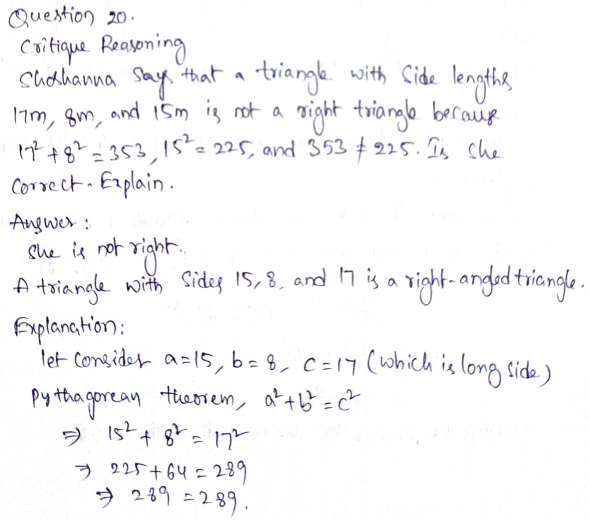
FOCUS ON HIGHER ORDER THINKING
Question 21.
Make a Conjecture Diondre says that he can take any right triangle and make a new right triangle just by doubling the side lengths. Is Diondre’s conjecture true? Test his conjecture using three different right triangles.
_______
Answer: Yes, Diondre’s conjecture is true. By doubling the sides of a right triangle would create a new right triangle.
Explanation: Given a right triangle, the Pythagorean Theorem holds. Therefore, a2 + b2 = c2
If we double the side lengths of that triangle, we get:
(2a)2 + (2b)2 = (2c)2
4a2 + 4b2 = 4c2
4(a2 + b2) = 4c2
a2 + b2 = c2
As we can see doubling the sides of a right triangle would create a new right triangle.We can test that by using three different right triangles.
The triangle with sides a = 6, b = 8 and c = 10 is a right triangle. We double its sides and check if the new triangle is a right triangle. After doubling value of a = 12, b = 16 and c = 20.
122 + 162 = 202
144 + 256 = 400
400 = 400
Hence proved!
Since 122 + 162 = 202, the new triangle is a right triangle by the converse of the Pythagorean Theorem.
The triangle with sides a = 3, b = 4 and c = 5 is a right triangle. We double its sides and check if the new triangle is a right triangle. After doubling value of a = 6, b = 8 and c = 10.
62 + 82 = 102
36 + 64 = 100
100 = 100
Hence proved!
Since 62 + 82 = 102, the new triangle is a right triangle by the converse of the Pythagorean Theorem.
The triangle with sides a = 12, b = 16 and c = 20 is a right triangle. We double its sides and check if the new triangle is a right triangle. After doubling value of a = 24, b = 32 and c = 40.
242 + 322 = 402
576 + 1024 = 1600
1600 = 1600
Hence proved!
Since 242 + 322 = 402, the new triangle is a right triangle by the converse of the Pythagorean Theorem.
Question 22.
Draw Conclusions A diagonal of a parallelogram measures 37 inches. The sides measure 35 inches and 1 foot. Is the parallelogram a rectangle? Explain your reasoning.
_______
Answer: Since 122 + 352 = 372, the triangle is right triangle. Therefore, the given parallelogram is a rectangle.
Explanation: A rectangle is a parallelogram where the interior angles are right angles. To prove if the given parallelogram is a rectangle, we need to prove that the triangle formed by the diagonal of the parallelogram and two sides of it, is a right triangle. Converting all the values into inches, we have a = 12, b = 35 and c = 37. Using the converse of the Pythagorean Theorem, we have:
a2 + b2 = c2
122 + 352 = 372
144 + 1225 = 1369
1369 = 1369.
Since 122 + 352 = 372, the triangle is right triangle. Therefore, the given parallelogram is a rectangle.
Question 23.
Represent Real-World Problems A soccer coach is marking the lines for a soccer field on a large recreation field. The dimensions of the field are to be 90 yards by 48 yards. Describe a procedure she could use to confirm that the sides of the field meet at right angles.
Answer: To confirm that the sides of the field meet at right angles, she could measure the diagonal of the field and use the converse of the Pythagorean Theorem. If a2 + b2 = c2 (where a = 90, b = 48, and c is the length of the diagonal), then the triangle is a right triangle. This method can be used for every corner to decide if they form right angles or not.
Guided Practice – Distance Between Two Points – Page No. 390
Question 1.
Approximate the length of the hypotenuse of the right triangle to the nearest tenth using a calculator.

_______ units
Answer: The length of the hypotenuse of the right triangle to the nearest tenth is 5.8 units.
Explanation: From the above figure let’s take
Length of the vertical leg = 3 units
Length of the horizontal leg = 5 units
let length of the hypotenuse = c
By using Pythagorean Theorem a2 + b2 = c2
c2 = 32 + 52
c2 = 9 +25
c = √34 => 5.830.
Therefore Length of the hypotenuse of the right triangle to the nearest tenth is 5.8 units.

Question 3.
A plane leaves an airport and flies due north. Two minutes later, a second plane leaves the same airport flying due east. The flight plan shows the coordinates of the two planes 10 minutes later. The distances in the graph are measured in miles. Use the Pythagorean Theorem to find the distance shown between the two planes.

_______ miles
Answer: The distance between the two planes is 103.6 miles.
Explanation:
Length of the vertical dv = √(80 -1)2 + √(1-1)2
= √792 => 79.
Length of the horizontal dh = √(68 -1)2 + √(1-1)2
= √672 => 67.
Distance between the two planes D = √(792 + 672)
= √(6241+4489) => √10730
= 103.5857 => 103.6 miles.
ESSENTIAL QUESTION CHECK-IN
Question 4.
Describe two ways to find the distance between two points on a coordinate plane.
Answer:
Explanation: We can draw a right triangle whose hypotenuse is the segment connecting the two points and then use the Pythagorean Theorem to find the length of that segment. We can also the Distance formula to find the length of that segment.
For example, plot three points; (1,2), (20,2), and (20,12)
Using the Pythagorean Theorem:
The length of the horizontal leg is the absolute value of the difference between the x-coordinates of points (1,2) and (20,2).
|1 – 20| = 19
The length of the horizontal leg is 19.
The length of the vertical leg is the absolute value of the difference between the y-coordinates of the points (20,2) and (20,12).
|2 – 12| = 10
The length of the vertical leg is 10.
Let a = 19, b = 10 and let c represent the hypotenuse. Find c.
a2 + b2 = c2
192 + 102 = c2
361 + 100 = c2
461 = c2
distance is 21.5 = c
Using the Distance formula:
d= √( x2 – x1)2 + √( y2 – y1)2
The length of the horizontal leg is between (1,2) and (20,2).
d= √( x2 – x1)2 + √( y2 – y1)2
= √(20 -1)2 + √(2-2)2
= √(19)2 + √(0)2
= √361 => 19
The length of the vertical leg is between (20,2) and (20,12).
d= √( x2 – x1)2 + √( y2 – y1)2
= √(20 -20)2 + √(12-2)2
= √(0)2 +√(10)2
= √100 => 10
The length of the diagonal leg is between (1,2) and (20,12).
d= √( x2 – x1)2 + √( y2 – y1)2
= √(20 -1)2 + √(12-2)2
= √(19)2 + √(10)2
= √(361+100) => √461 = 21.5
12.3 Independent Practice – Distance Between Two Points – Page No. 391
Question 5.
A metal worker traced a triangular piece of sheet metal on a coordinate plane, as shown. The units represent inches. What is the length of the longest side of the metal triangle? Approximate the length to the nearest tenth of an inch using a calculator. Check that your answer is reasonable.
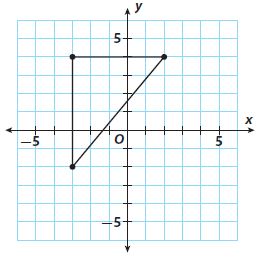
_______ in.
Answer: The length of the longest side of the metal triangle to the nearest tenth is 7.8 units.
Explanation: From the above figure let’s take
Length of the vertical leg = 6 units
Length of the horizontal leg = 5 units
let length of the hypotenuse = c
By using Pythagorean Theorem a2 + b2 = c2
c2 = 62 + 52
c2 = 36 +25
c = √61 => 7.8
Therefore Length of the longest side of the metal triangle to the nearest tenth is 7.8 units.
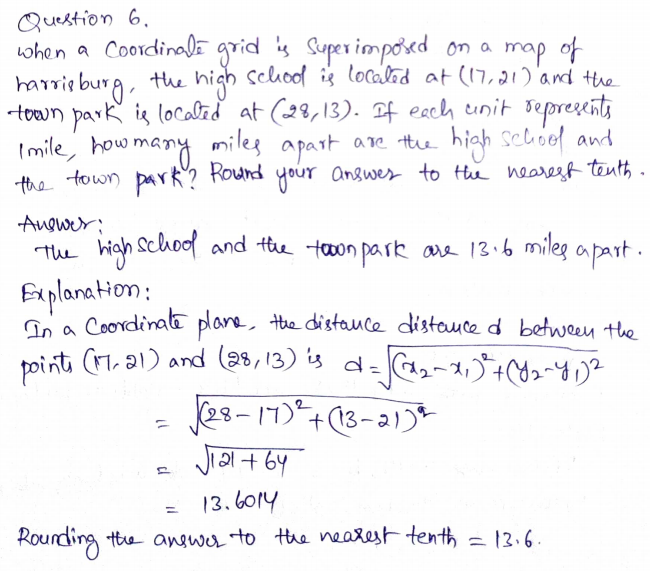
Question 7.
The coordinates of the vertices of a rectangle are given by R(- 3, – 4), E(- 3, 4), C (4, 4), and T (4, – 4). Plot these points on the coordinate plane at the right and connect them to draw the rectangle. Then connect points E and T to form diagonal \(\overline { ET } \).
a. Use the Pythagorean Theorem to find the exact length of \(\overline { ET } \).
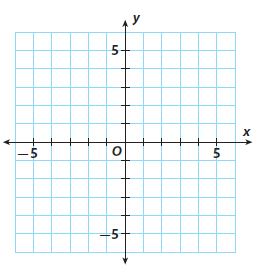
Answer: The diagonal ET is about 10.63 units long.
Explanation:
Taking into consideration the triangle TRE, the length of the vertical leg (ER) is 8 units. The length of the horizontal leg (RT) is 7 units. Let a = 8 and b =7. Let c represent the length of the hypotenuse, the diagonal ET. We use the Pythagorean Theorem to find c.
a2 + b2 = c2
c2 = 82 + 72
c2 = 64 +49
c = √113 => 10,63.
The diagonal ET is about 10.63 units long.
Question 7.
b. How can you use the Distance Formula to find the length of \(\overline { ET } \) ? Show that the Distance Formula gives the same answer.
Answer: The diagonal ET is about 10.63 units long. As we can see the answer is the same as the one we found using the Pythagorean Theorem.
Explanation: Using the distance formula, in a coordinate plane, the distance d between the points E(-3,4) and T(4, -4) is:
d= √( x2 – x1)2 + √( y2 – y1)2
= √(4 – (-3))2 + √(- 4 – 4)2
= √(7)2 + √(-8)2
= √(49+64) => √113 = 10.63.
The diagonal ET is about 10.63 units long. As we can see the answer is the same as the one we found using the Pythagorean Theorem.
Question 8.
Multistep The locations of three ships are represented on a coordinate grid by the following points: P(- 2, 5), Q(- 7, – 5), and R(2, – 3). Which ships are farthest apart?
Answer: Ships P and Q are farthest apart
Explanation: Distance Formula: In a coordinate plane, the distance d between two points (x1,y1) and (x2,y2) is:
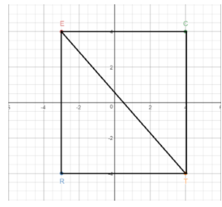
d= √( x2 – x1)2 + √( y2 – y1)2
The distance d1 between the two points P(-2,5) and Q(-7,-5) is:
d1 = √( xQ – xP)2 + √( yQ – yP)2
= √(-7 – (-2))2 + √(- 5 – 5)2
= √(-5)2 + √(-10)2
= √(25+100) => √125 = 11.18
The distance d2 between the two points Q(-7,-5) and R(2,-3) is:
d3 = √( xR – xQ)2 + √( yR – yQ)2
= √(2 – (-7))2 + √(- 3 – 5)2
= √(9)2 + √(2)2
= √(81+4) => √85 = 9.22
The distance d3 between the two points P(-2,5) and R(2,-3) is:
d3 = √( xR – xP)2 + √( yR – yP)2
= √(2 – (-2))2 + √(- 3 – 5)2
= √(4)2 + √(-8)2
= √(16+64) => √80 = 8.94.
As we can see, the greatest distance is d1 11.8, which means that ships P and Q are farthest apart.
Distance Between Two Points – Page No. 392
Question 9.
Make a Conjecture Find as many points as you can that are 5 units from the origin. Make a conjecture about the shape formed if all the points 5 units from the origin were connected.
Answer: (0,5), (3,4), (4,3),(5,0),(4,-3),(3,-4),(0,-5),(-3,-4),(-4,-3),(-5,0),(-4,3),(-3,4).
Explanation: Some of the points that are 5 units away from the origin are: (0,5), (3,4), (4,3),(5,0),(4,-3),(3,-4),(0,-5),(-3,-4),(-4,-3),(-5,0),(-4,3),(-3,4) etc, If all the points 5 units away from the origin are connected, a circle would be formed.

Question 10.
Justify Reasoning The graph shows the location of a motion detector that has a maximum range of 34 feet. A peacock at point P displays its tail feathers. Will the motion detector sense this motion? Explain.

Answer: Considering each unit represents 1 foot, the motion detector, and peacock are 33.5 feet apart. Since the motion detector has a maximum range of 34 feet, it means that it will sense the motion of the peacock’s feathers.
Explanation: The coordinates of the motion detector are said to be (0,25), whereas the coordinates of the peacock are (30,10). In a coordinate plane, the distance d between the points (0,25) and (30,10) is:
d = √( x2 – x1)2 + √( y2 – y1)2
= √(30 – 0)2 + √(10 – 25)2
= √(30)2 + √(-15)2
= √(900+225) => √1125.
Rounding answer to the nearest tenth:
d = 33.5 feet.
Considering each unit represents 1 foot, the motion detector and peacock are 33.5 feet apart. Since the motion detector has a maximum range of 34 feet, it means that it will sense the motion of the peacock’s feathers.
FOCUS ON HIGHER ORDER THINKING
Question 11.
Persevere in Problem Solving One leg of an isosceles right triangle has endpoints (1, 1) and (6, 1). The other leg passes through the point (6, 2). Draw the triangle on the coordinate plane. Then show how you can use the Distance Formula to find the length of the hypotenuse. Round your answer to the nearest tenth.
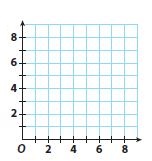
Answer: 7.1 units.
Explanation:
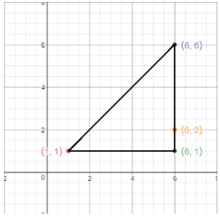
One leg of an isosceles right triangle has endpoints (1,1) and (6,1), which means that the leg is 5 units long. Since the triangle is isosceles, the other leg should be 5 units long too, therefore the endpoints of the second leg that passes through the point (6,2) are (6,1) and (6,6).
In the coordinate plane, the length of the hypotenuse is the distance d between points (1,1) and (6,6).
d = √( x2 – x1)2 + √( y2 – y1)2
= √(6 – 1)2 + √(6 – 1)2
= √(5)2 + √(5)2
= √(25+25) => √50.
Rounding answer to nearest tenth:
d = 7.1.
The hypotenuse is around 7.1 units long.
Question 12.
Represent Real-World Problems The figure shows a representation of a football field. The units represent yards. A sports analyst marks the locations of the football from where it was thrown (point A) and where it was caught (point B). Explain how you can use the Pythagorean Theorem to find the distance the ball was thrown. Then find the distance.

_______ yards
Answer: The distance between point A and B is 37 yards
Explanation:
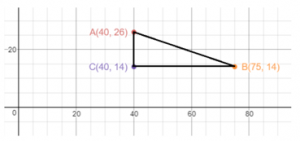
To find the distance between points A and B, we draw segment AB and label its length d. Then we draw the vertical segment AC and Horizontal segment CB. We label the lengths of these segments a and b. triangle ACB is a right triangle with hypotenuse AB.
Since AC is a vertical segment, its length, a, is the difference between its y-coordinates. Therefore, a = 26 – 14 = 12 units.
Since CB is a horizontal segment, its length b is the difference between its x-coordinates. Therefore, b = 75 – 40 = 35units.
We use the Pythagorean Theorem to find d, the length of segment AB.
d2 = a2 + b2
d2 = 122 + 352
d2 = 144 + 1225
d2 = 1369 => d = √1369 => 37
The distance between points A and B is 37 yards
Ready to Go On? – Model Quiz – Page No. 393
12.1 The Pythagorean Theorem
Find the length of the missing side.
Question 1.
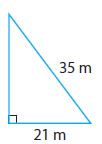
________ meters
Answer: Length of the missing side is 28m
Explanation: Lets consider value of a = 21 and c = 35.
Using Pythagorean Theorem a2 + b2 = c2
212 + b2 = 352
441 + b2 = 1225
b2= 784 => b = √784 = 28.
Therefore length of missing side is 28m.
Question 2.
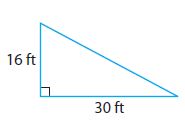
________ ft
Answer: Length of missing side is 34ft
Explanation: Let’s consider value of a = 16 and b = 30.
Using Pythagorean Theorem a2 + b2 = c2
162 + 302 = c2
256 + 900 = c2
c2= 1156 => c = √1156 = 34.
Therefore length of missing side is 34ft.
12.2 Converse of the Pythagorean Theorem
Tell whether each triangle with the given side lengths is a right triangle.
Question 3.
11, 60, 61
____________
Answer: Since 112 + 602 = 612, by the converse of the Pythagorean Theorem, we say that the given sides are in the shape of right-angled triangle.
Explanation: Let a = 11, b = 60 and c= 61
Using the converse of the Pythagorean Theorem a2 + b2 = c2
112 + 602 = 612
121 + 3600 = 3721
3721 = 3721
Since 112 + 602 = 612, by the converse of the Pythagorean Theorem, we say that the given sides are in the shape of right-angled triangle.
Question 4.
9, 37, 40
____________
Answer: Since 92 + 372 ≠ 402, by the converse of the Pythagorean Theorem, we say that the given sides are not in the shape of a right-angled triangle.
Explanation: Let a = 9, b = 37 and c= 40
Using the converse of the Pythagorean Theorem a2 + b2 = c2
92 + 372 = 402
81 + 1369 = 1600
1450 ≠ 3721.
Since 92 + 372 ≠ 402, by the converse of the Pythagorean Theorem, we say that the given sides are not in the shape of a right-angled triangle.

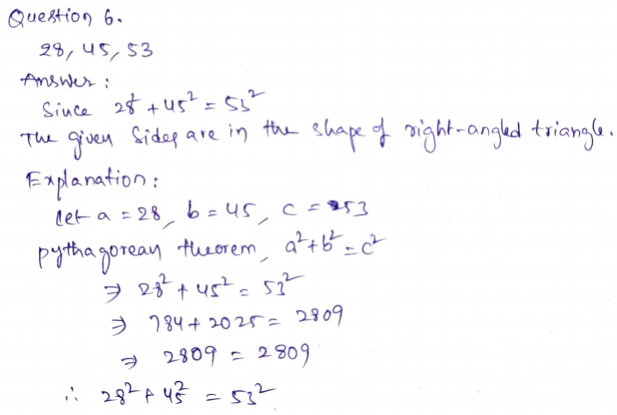
Question 7.
Keelie has a triangular-shaped card. The lengths of its sides are 4.5 cm, 6 cm, and 7.5 cm. Is the card a right triangle?
____________
Answer: Since 4.52 + 62 = 7.52, by the converse of the Pythagorean Theorem, we say that the given sides are in the shape of a right-angled triangle.
Explanation: Let a = 4.5, b = 6 and c= 7.5
Using the converse of the Pythagorean Theorem a2 + b2 = c2
4.52 + 62 = 7.52
20.25 + 36 = 56.25
56.25= 56.25
Since 4.52 + 62 = 7.52, by the converse of the Pythagorean Theorem, we say that the given sides are in the shape of a right-angled triangle.
12.3 Distance Between Two Points
Find the distance between the given points. Round to the nearest tenth.

Question 8.
A and B
________ units
Answer: The distance between A and B is 6.7 units
Explanation: A= (-2,3) and B= (4,6)
Distance between A and B is d = √( x2 – x1)2 + √( y2 – y1)2
= √(4 – (-2)2 + √(6 – 3)2
= √(6)2 + √(3)2
= √(36+9) => √45 = 6.7 units
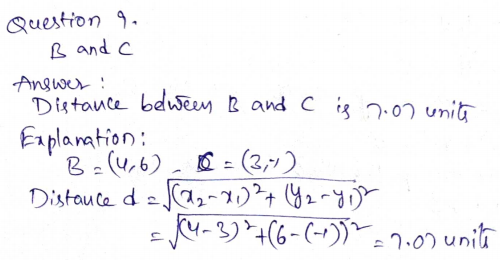

ESSENTIAL QUESTION
Question 11.
How can you use the Pythagorean Theorem to solve real-world problems?
Answer:
We can use the Pythagorean Theorem to find the length of a side of a right triangle when we know the lengths of the other two sides. This application is usually used in architecture or other physical construction projects. For example, it can be used to find the length of a ladder, if we know the height of the wall and the distance on the ground from the wall of the ladder.
Selected Response – Mixed Review – Page No. 394
Question 1.
What is the missing length of the side?

A. 9 ft
B. 30 ft
C. 39 ft
D. 120 ft
Answer: C
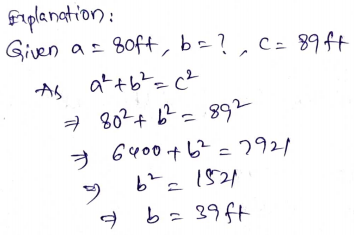
Question 2.
Which relation does not represent a function?
Options:
A. (0, 8), (3, 8), (1, 6)
B. (4, 2), (6, 1), (8, 9)
C. (1, 20), (2, 23), (9, 26)
D. (0, 3), (2, 3), (2, 0)
Answer: D
Explanation: The value of X is the same for 2 points and 2 values of Y [(2, 3), (2, 0)]. The value of X is repeated for a function to exist, no two points can have the same X coordinates.
Question 3.
Two sides of a right triangle have lengths of 72 cm and 97 cm. The third side is not the hypotenuse. How long is the third side?
Options:
A. 25 cm
B. 45 cm
C. 65 cm
D. 121 cm
Answer: C
Explanation:
Given a= 72 cm
b= ?
c= 97 cm
As a2+b2=c 2
722+b2= 972
5,184+b2= 9,409
b2= 9,409-5,184
b= √4,225
b= 65 cm.
Question 4.
To the nearest tenth, what is the distance between point F and point G?

Options:
A. 4.5 units
B. 5.0 units
C. 7.3 units
D. 20 units
Answer: A.
Explanation:
Given F= (-1,6) =(x1,y1).
G= (3,4) = (x2,y2).
The difference between F&G points is
d= √(x2-x1)2 + (y2-y1)2
= √(3 – (-1))2 + (4 – 6)2
= √(4)2 + (-2)2
= √16+4
= √20
= 4.471
= 4.5 units.
Question 5.
A flagpole is 53 feet tall. A rope is tied to the top of the flagpole and secured to the ground 28 feet from the base of the flagpole. What is the length of the rope?
Options:
A. 25 feet
B. 45 feet
C. 53 feet
D. 60 feet
Answer: D
Explanation:
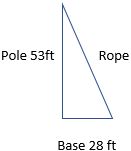
By Pythagorean theorem
a2+b2=c 2
532+282= C2
2,809+784= C2
C2 = 9,409-5,184
C2 = 3,593
C= √3,593
C= 59.94 feet
=60 feet.
Question 6.
Which set of lengths is not the side lengths of a right triangle?
Options:
A. 36, 77, 85
B. 20, 99, 101
C. 27, 120, 123
D. 24, 33, 42
Answer: D.
Explanation:
Check if side lengths in option A form a right triangle.
Let a= 36, b= 77, c= 85
By Pythagorean theorem
a2+b2=c 2
362+772= 852
1,296+ 5,929= 7,225
7,225= 7,225
As 362+772= 852 the triangle is a right triangle.
Check if side lengths in option B form a right triangle.
Let a= 20, b= 99, c= 101
By Pythagorean theorem
a2+b2=c 2
202+992= 1012
400+ 9,801= 10,201
10,201= 10,201
As 202+992= 1012 the triangle is a right triangle.
Check if side lengths in option B form a right triangle.
Let a= 27, b= 120, c= 123
By Pythagorean theorem
a2+b2=c 2
272+1202= 1232
729+ 14,400= 15,129
15,129= 15,129
As 272+1202= 1232 the triangle is a right triangle.
Check if side lengths in option B form a right triangle.
Let a= 27, b= 120, c= 123
By Pythagorean theorem
a2+b2=c 2
242+332= 422
576+ 1,089= 1,764.
1,665= 1,764
As 242+332 is not equal to 422 the triangle is a right triangle.
Question 7.
A triangle has one right angle. What could the measures of the other two angles be?
Options:
A. 25° and 65°
B. 30° and 15°
C 55° and 125°
D 90° and 100°
Answer:
A. 25° and 65°

Mini-Task
Question 8.
A fallen tree is shown on the coordinate grid below. Each unit represents 1 meter.

a. What is the distance from A to B?
_______ meters
Answer: 13.34 m.
Explanation:
A= (-5,3)
B= (8,0)
Distance between A & B is
D= √{8-(-5)2 + (0-3)2
= √(13)2 + (-3)2
= √169+9
= √178
= 13.34 m.
Question 8.
b. What was the height of the tree before it fell?
_______ meters
Answer: 16.3 m.
Explanation:
Length of the broken part= 13.3 m
Length of vertical part= 3 m
Total Length = 13.3 m + 3 m
= 16.3 m.
Final Words
In addition to the exercise problems, we have provided the solutions for the review questions. So all the students are requested to test their knowledge and solve the problems provided at the end of this chapter. Refer to HMH Go Math Grade 8 Answer Key and try to score the highest marks in the exams. Hope you liked the explanations provided in this chapter. Stay tuned to get the solutions according to the list of the chapters of all the grades.
Refer:
CANFINHOME Pivot Calculator


